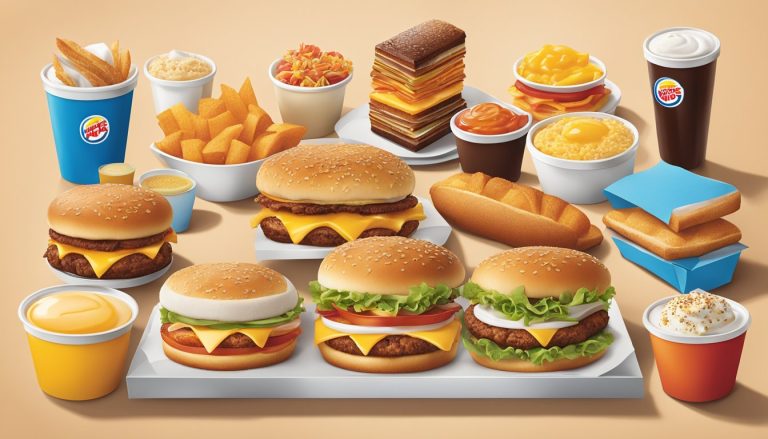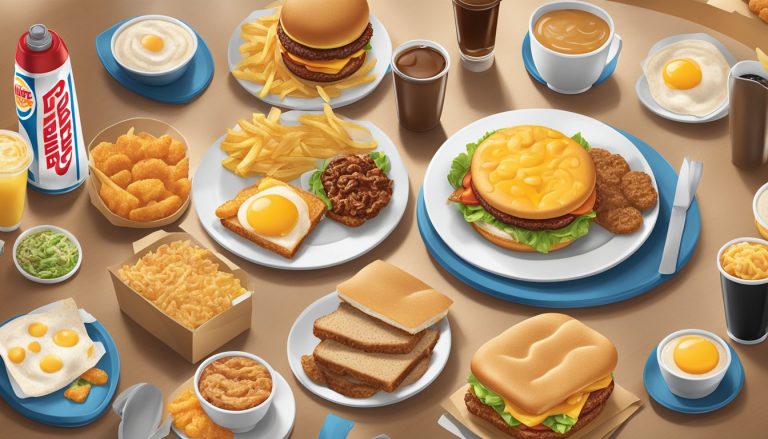Burger King’s breakfast menu has become an integral part of American fast food culture since its introduction in 1983. The Croissan’wich, a flaky croissant sandwich filled with eggs, cheese, and a choice of meat, quickly became a signature item that has endured for decades. This innovative creation exemplifies how Burger King adapted traditional breakfast fare to suit the on-the-go lifestyle of modern Americans.
The evolution of Burger King’s breakfast offerings reflects broader trends in American eating habits. From classic items like hash browns to more recent additions such as breakfast burritos, the menu caters to diverse tastes and preferences. This variety demonstrates the company’s understanding of its customers’ desire for both familiar comfort foods and novel options to start their day.
Burger King’s breakfast menu also highlights the American preference for convenience without sacrificing flavor. The combination of savory and sweet items, from egg sandwiches to pancakes, provides choices for different palates and moods. As with many aspects of fast food, moderation is key when enjoying these breakfast options as part of a balanced diet.
Overview of Burger King’s Place in American Fast Food
Burger King has been a major player in shaping American fast food culture since its founding. The chain’s breakfast menu reflects changing consumer tastes and preferences over the decades.
History of Burger King and Its Breakfast Expansion
Burger King opened its first restaurant in 1954 in Miami, Florida. The chain grew rapidly, becoming a household name across the United States. In 1978, Burger King introduced its breakfast menu, expanding beyond burgers and fries.
The iconic Croissan’wich debuted in 1983, combining a flaky croissant with classic breakfast ingredients. This innovative sandwich helped Burger King carve out a unique position in the competitive breakfast market.
By the 1990s, Burger King had established itself as a go-to destination for quick, affordable breakfasts. The menu continued to evolve, adding options like breakfast burritos and platters to cater to changing consumer preferences.
Influence of Burger King on American Breakfast Culture
Burger King’s breakfast offerings have significantly impacted American eating habits. The chain popularized the concept of grab-and-go breakfast sandwiches, making it acceptable to eat a hearty morning meal on the run.
The introduction of all-day breakfast items at some locations further blurred the lines between traditional meal times. This shift aligned with Americans’ increasingly busy lifestyles and desire for flexibility in their eating schedules.
Burger King’s breakfast menu has also influenced other fast food chains, sparking competition and innovation in the industry. The focus on value, with many items priced affordably, has set expectations for breakfast pricing across the fast food landscape.
Dissecting BK’s Breakfast Menu
Burger King’s breakfast menu reflects a blend of traditional American breakfast staples and fast-food innovation. It caters to diverse tastes while maintaining efficiency in preparation and service.
Core Components of BK’s Breakfast Offerings
The foundation of Burger King’s breakfast menu lies in its classic ingredients. Eggs, bacon, sausage, and cheese form the basis of many offerings. These components are versatile, allowing for various combinations.
Hash browns serve as a popular side dish, providing a crispy texture to complement sandwich options. American cheese adds a familiar flavor profile to many breakfast items.
Bread choices include croissants, biscuits, and English muffins. These options cater to different preferences and regional tastes across the United States.
Signature Breakfast Items and Their Popularity
The Croissan’wich stands out as a Burger King breakfast icon. This sandwich combines eggs, cheese, and a choice of meat on a flaky croissant. Its popularity stems from its portability and satisfying flavor combination.
French Toast Sticks offer a sweet alternative, appealing to those who prefer a non-savory breakfast. These portable, dippable items are especially popular with younger customers.
The Egg-Normous Burrito caters to hearty appetites. It packs eggs, sausage, hash browns, and cheese into a tortilla, providing a substantial meal option.
Nutritional Value and Ingredient Sourcing
Burger King’s breakfast items vary in nutritional content. While some options are high in calories and saturated fat, others offer more balanced choices.
Egg-based items provide protein, essential for morning energy. However, many breakfast sandwiches are also high in sodium and cholesterol.
BK has made efforts to improve ingredient quality. They’ve committed to sourcing cage-free eggs and eliminating artificial colors and flavors from their menu items.
Portion sizes play a significant role in nutritional impact. Smaller items like hash browns can be lower in calories, while larger sandwiches and burritos pack more nutrients but also more calories.
BK’s Unique Breakfast Selections
Burger King’s breakfast menu features innovative offerings that set it apart from competitors. The Croissan’wich and BK Café line showcase the chain’s commitment to distinctive morning options.
Examining the Croissan’wich Varieties
The Croissan’wich is a signature Burger King breakfast item. It combines a flaky croissant with savory fillings. Options include ham, sausage, bacon, or egg and cheese.
For those seeking plant-based alternatives, BK introduced the Impossible Croissan’wich. This version features a patty made from plants that mimics the taste of sausage.
Croissan’wiches are customizable, allowing customers to add or remove ingredients. This flexibility caters to various dietary preferences and tastes.
Distinctiveness of the BK Café Offerings
BK Café represents Burger King’s foray into premium coffee offerings. The line includes hot and iced coffee options to suit different preferences.
Hot coffee choices range from classic brews to flavored varieties. Iced coffee provides a refreshing alternative for warm days or those who prefer cold beverages.
BK Café also offers specialty drinks like lattes and cappuccinos. These options aim to compete with dedicated coffee shops, providing customers with café-style beverages in a fast-food setting.
The coffee is made from 100% Arabica beans, emphasizing quality. This focus on premium ingredients aligns with growing consumer demand for better coffee options in quick-service restaurants.
Evolution of Breakfast at Burger King

Burger King’s breakfast menu has undergone significant changes since its inception in 1979. The chain has continuously adapted to shifting consumer preferences and dietary trends.
From Classic to Contemporary: The Transforming Menu
Burger King’s breakfast journey began with the introduction of the Croissan’wich in 1983. This innovative sandwich quickly became a fan favorite, combining the flaky texture of a croissant with classic breakfast ingredients.
The menu expanded to include the Breakfast Burrito, offering a portable option for on-the-go customers. Breakfast Platters were added to cater to those seeking a heartier meal.
Pancakes joined the lineup, providing a sweet alternative to savory options. As competition intensified, Burger King introduced Breakfast Combos, allowing customers to bundle items for better value.
Adoption of Plant-Based Options and Consumer Response
In 2020, Burger King made waves by launching the Impossible Croissan’wich. This plant-based offering aimed to attract health-conscious and vegetarian customers.
The move reflected growing consumer demand for meat alternatives. Initial response was mixed, with some praising the innovation and others preferring traditional options.
Burger King has since continued to refine its plant-based breakfast items. The chain now offers a balance of classic favorites and contemporary choices to appeal to a diverse customer base.
Operational Excellence Behind BK’s Morning Service

Burger King’s breakfast success relies on streamlined operations and efficient service delivery. The chain has implemented key strategies to optimize its morning offerings while maintaining quality and speed.
Role of Drive-Thru Efficiency during Breakfast Hours
Drive-thru service is crucial for Burger King’s breakfast operations. The company has invested in technology to reduce wait times and improve order accuracy. Digital menu boards and mobile ordering options allow customers to preview selections before arriving.
BK has also redesigned drive-thru layouts to accommodate multiple lanes during peak hours. This helps manage traffic flow and reduces bottlenecks. Staff receive specialized training to handle the unique demands of breakfast service.
The chain closely monitors drive-thru performance metrics. Managers use this data to adjust staffing levels and identify areas for improvement.
Strategies for Consistent Quality and Speed
Burger King employs several tactics to maintain food quality and service speed during breakfast hours. Prep work begins well before opening, with ingredients portioned and equipment preheated.
The kitchen layout is optimized for breakfast item assembly. Staff follow standardized procedures for cooking and plating to ensure consistency. Popular items like Croissan’wiches are partially pre-assembled to reduce preparation time.
BK uses specialized equipment, such as high-speed toasters, to expedite service. The chain’s flame-grilled cooking method extends to breakfast meats, providing a signature flavor profile.
Quality control checks are performed regularly throughout the morning. This helps maintain food safety standards and ensures that customers receive fresh, hot meals.
Consumer Habits and Breakfast Patterns

Breakfast habits in America have evolved significantly, reflecting changes in lifestyle and food preferences. Consumer choices now encompass a wider range of options, from traditional favorites to innovative breakfast items.
Impact of Lifestyle Changes on Breakfast Choices
Busy schedules have led to a rise in on-the-go breakfast options. Breakfast sandwiches and burritos have become popular choices for their convenience and portability. Many consumers opt for these handheld meals during their morning commutes.
The demand for healthier options has also increased. Fluffy eggs, once mainly a weekend indulgence, are now sought after on weekdays too. This shift reflects a growing awareness of the importance of protein-rich breakfasts.
Work-from-home trends have influenced breakfast routines. More people now have time for sit-down breakfasts, leading to a resurgence in traditional morning meals.
Analysis of Customer Preferences and Trends
Customization is key in current breakfast trends. Consumers desire the ability to tailor their morning meals to their specific tastes and dietary needs. This has led to the popularity of build-your-own breakfast options.
Ethnic flavors are gaining traction in breakfast menus. Mexican-inspired breakfast burritos and Asian-influenced morning bowls are becoming mainstream choices. This trend reflects America’s diverse culinary landscape.
Plant-based alternatives are on the rise. Many consumers now seek vegetarian or vegan versions of classic breakfast items, including egg substitutes and plant-based breakfast sandwiches.
Breakfast for dinner, or “brinner,” has become a notable trend. This shift demonstrates the blurring lines between traditional meal times and the increasing desire for breakfast foods throughout the day.
Marketing and Promotional Techniques

Burger King employs diverse strategies to promote its breakfast menu, aiming to capture a larger share of the morning market. These efforts highlight their unique offerings and competitive pricing.
Advertising Campaigns Geared Towards Breakfast Options
Burger King’s breakfast marketing often focuses on convenience and value. TV commercials showcase their breakfast sandwiches, emphasizing the melted cheese and savory meat options.
Digital ads target commuters, promoting grab-and-go items like breakfast burritos. Social media campaigns feature limited-time offers on breakfast combos, encouraging early morning visits.
Burger King frequently uses humor in their breakfast ads. One notable campaign poked fun at competitors by offering coffee subscriptions for just $5 per month.
In-store promotions play a key role. Eye-catching posters display breakfast menu items, while staff often suggest breakfast upgrades or additions at the counter.
Collaborations with popular brands or celebrities sometimes feature in breakfast promotions, creating buzz and attracting new customers to try morning options.
Looking Ahead: The Future of BK’s Breakfast

Burger King’s breakfast menu continues to evolve, adapting to changing consumer preferences and industry trends. The fast food giant aims to stay competitive in the morning meal market through strategic innovations and menu enhancements.
Innovations in Menu Items and Service Models
Burger King plans to introduce new breakfast sandwiches featuring premium ingredients and unique flavor combinations. The chain is exploring options like artisanal breads and locally-sourced eggs to appeal to health-conscious customers.
BK is also considering expanding its Ultimate Breakfast Platter with customizable options. This move would allow diners to create personalized combinations of pancakes, eggs, and breakfast meats.
The Egg-Normous Burrito may see updates with international flavors, catering to diverse palates. Burger King is testing variations like a Mediterranean-inspired burrito with feta cheese and spinach.
Digital ordering and delivery services for breakfast items are set to improve. BK is developing a mobile app feature for customized breakfast orders and exploring partnerships with food delivery platforms to reach more customers.
Sustainability initiatives are on the horizon for BK’s breakfast packaging. The company aims to introduce eco-friendly containers for items like the Pancake Platter, aligning with growing environmental concerns.




